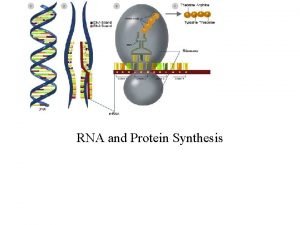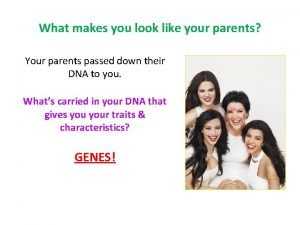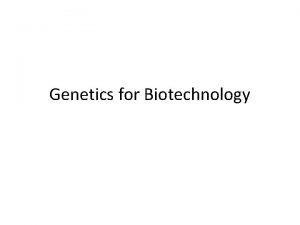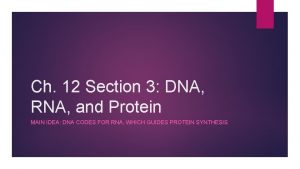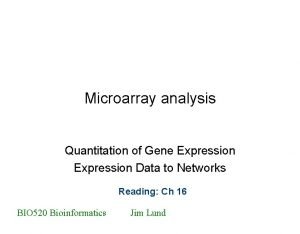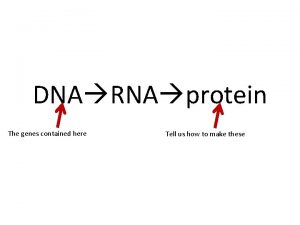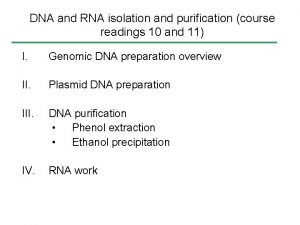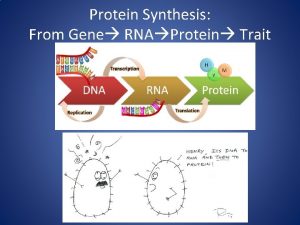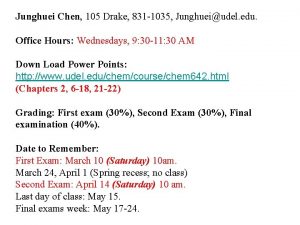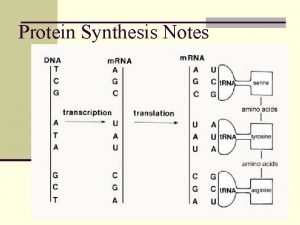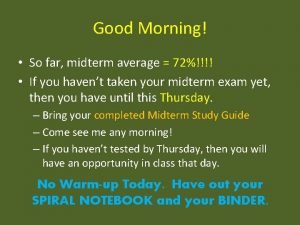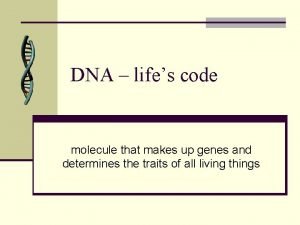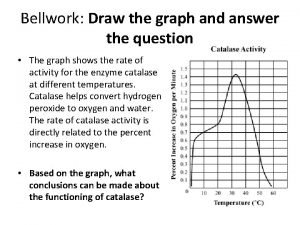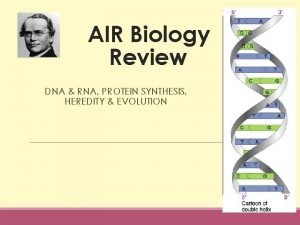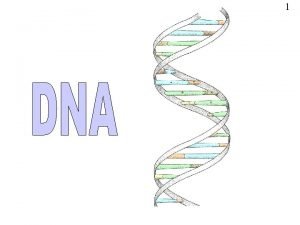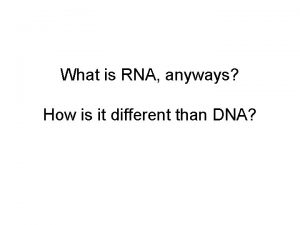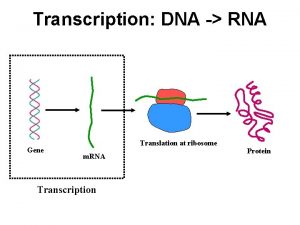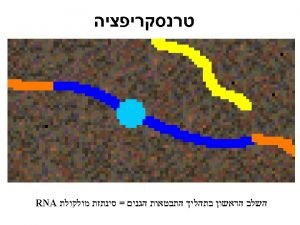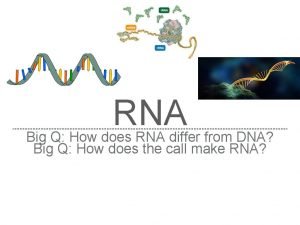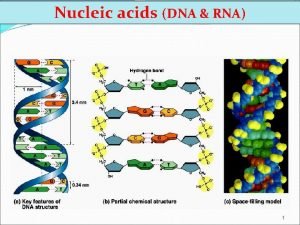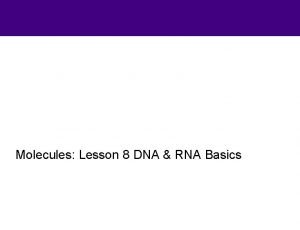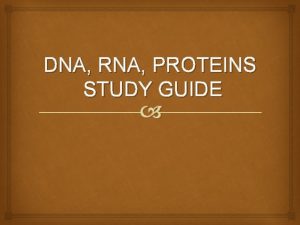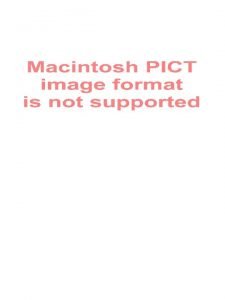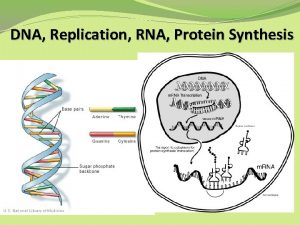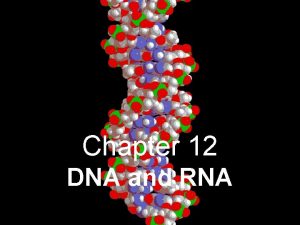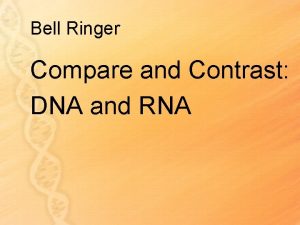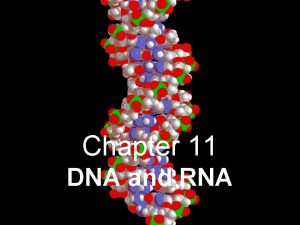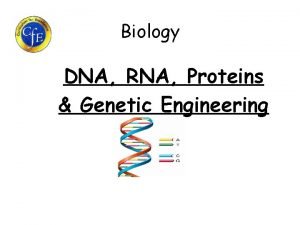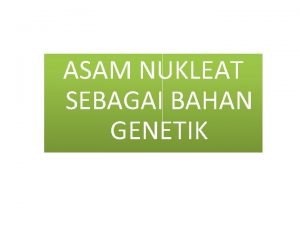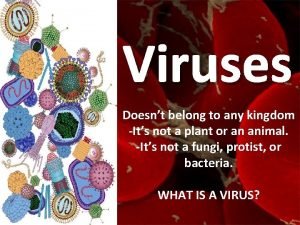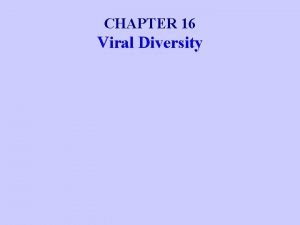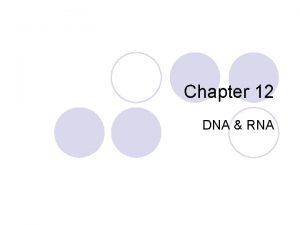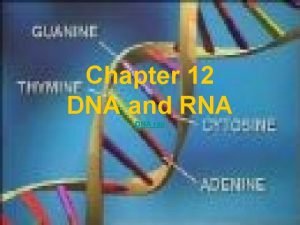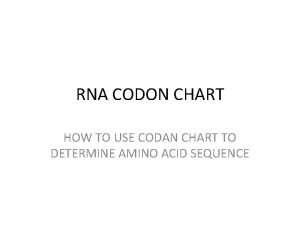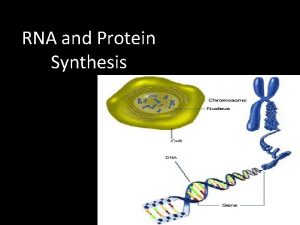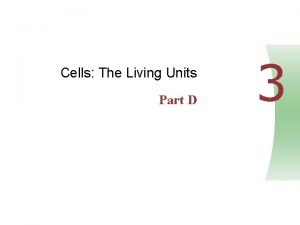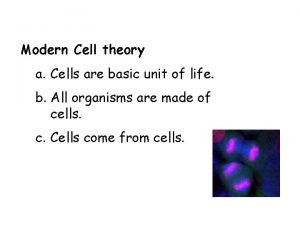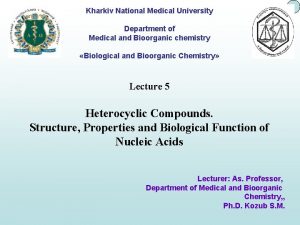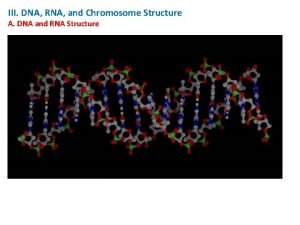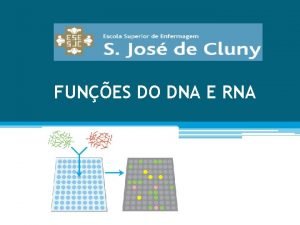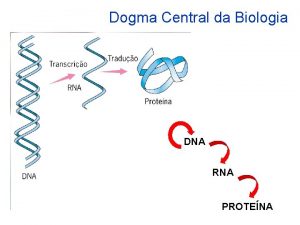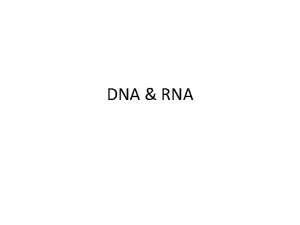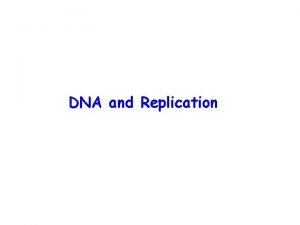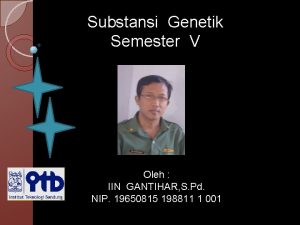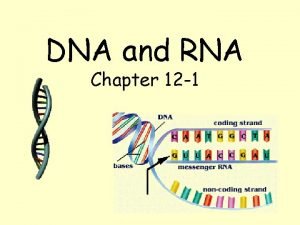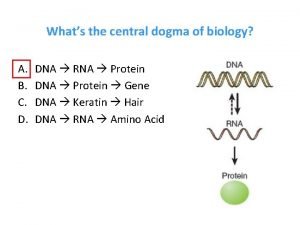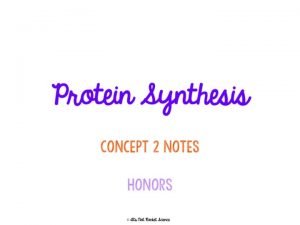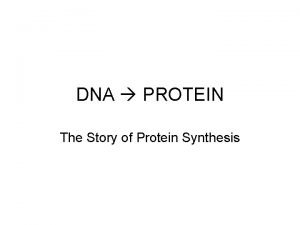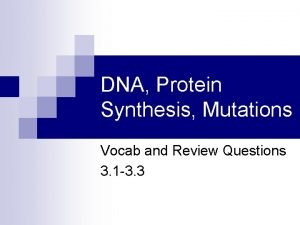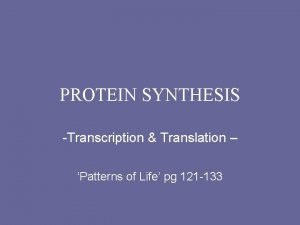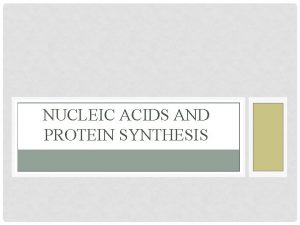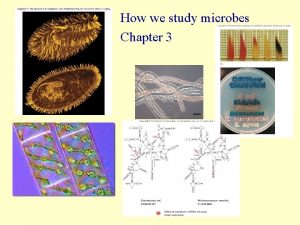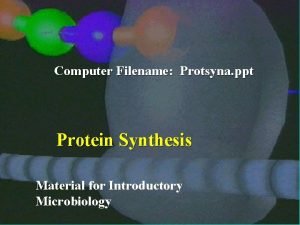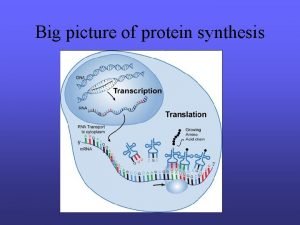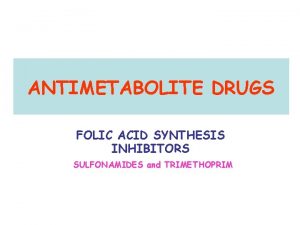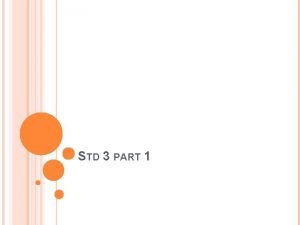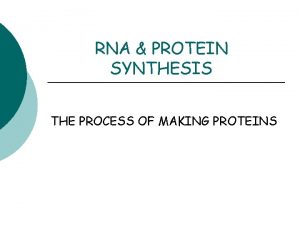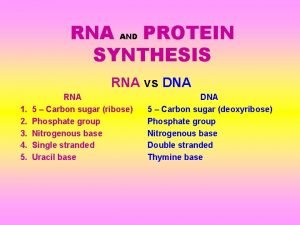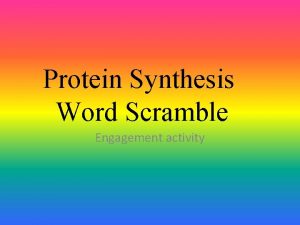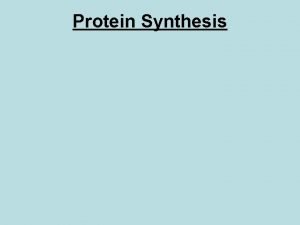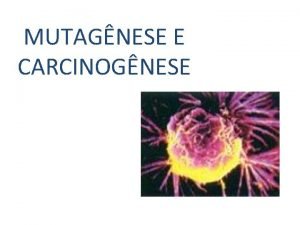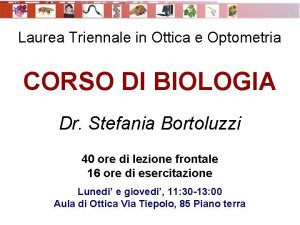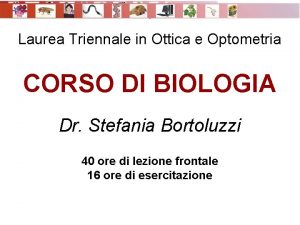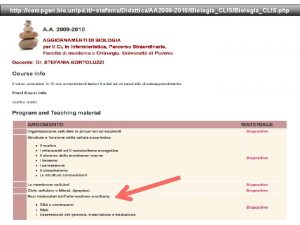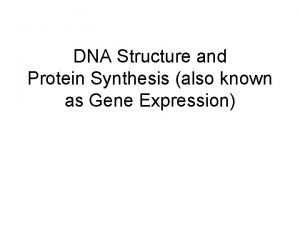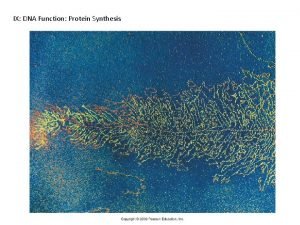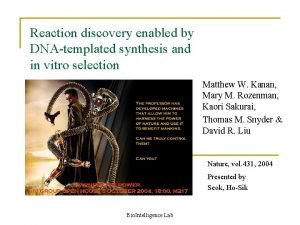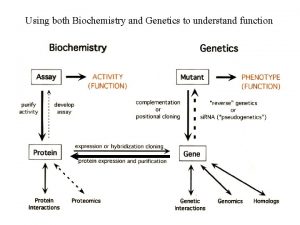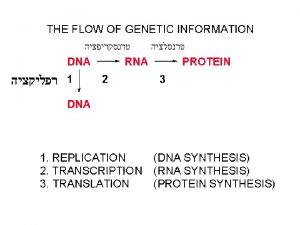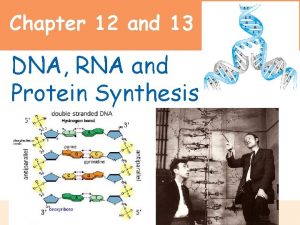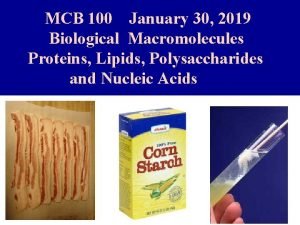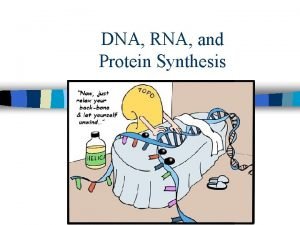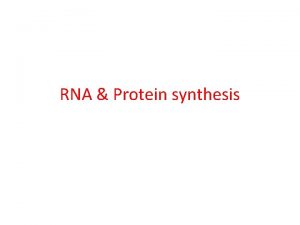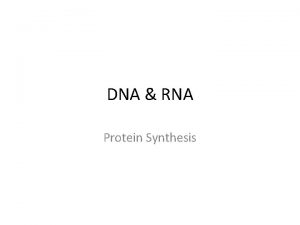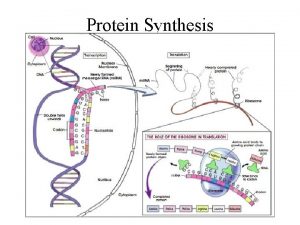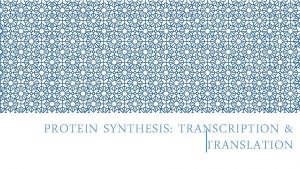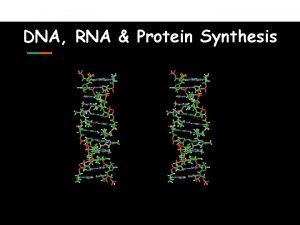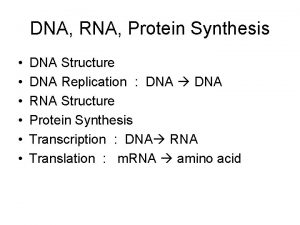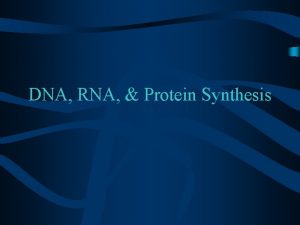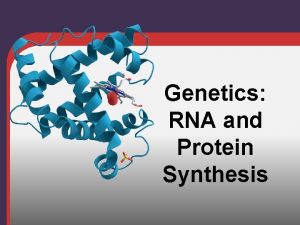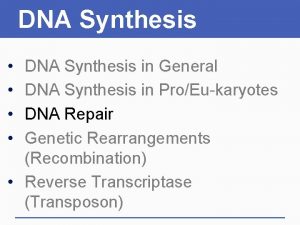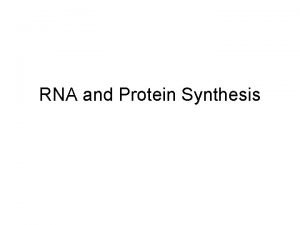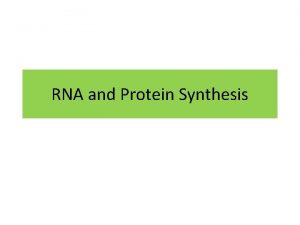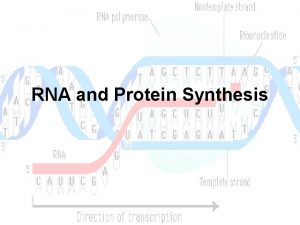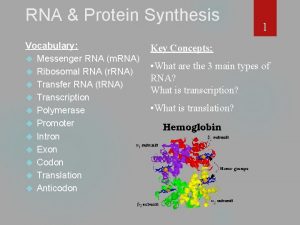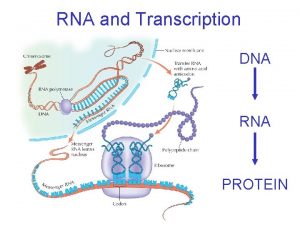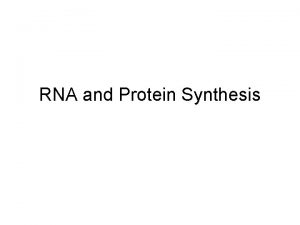Review Sheet DNA RNA Protein Synthesis Question 1


































































































- Slides: 98

Review Sheet: DNA, RNA & Protein Synthesis


Question #1 Molecules of DNA are composed of long chains of _______

Answer to Question #1 Nucleotides

Question #2 A nucleotide consists of _______, and _____.

Answer to Question #2 a sugar, a phosphate group, and a nitrogen base.

Question #3 The part of the molecule for which deoxyribonucleic acid is named is the _______

Answer to Question #3 sugar - deoxyribose

Question #4 Of the four nitrogen bases in DNA, which two are purines and which two are pyrimidines?

Answer to Question #4 �Purines are Adenine and Guanine �Pyrimidines are Thymine and Cytosine

Question #5 Which of the following is not true about DNA replication? a. It occurs during the S phase of cell cycle b. Two complementary strands are duplicated. c. The double strand unwinds and unzips while it is being duplicated. d. The process is catalyzed by enzymes called DNA mutagens.

Answer to Question #5 d. The process is catalyzed by enzymes called DNA mutagens.

Question #6 RNA differs from DNA in that RNA a. _______ b. _______ c. _______

Answer to Question #6 is single-stranded. contains the nitrogen base uracil. contains a different sugar molecule.

Question #7 In RNA molecules, adenine is complementary to _______

Answer to Question #7 uracil

Question #8 The function of r. RNA is to form _______

Answer to Question #8 ribosomes

Question #9 During transcription, the genetic information for making a protein is “rewritten” as a molecule of _______

Answer to Question #9 messenger RNA

Question #10 Each nucleotide triplet in m. RNA that specifies a particular amino acid is called a(n) _______

Answer to Question #10 codon

Question #11 Each of the following is a type of RNA except a. b. c. d. carrier RNA. messenger RNA. ribosomal RNA. transfer RNA.

Answer to Question #11 a. carrier RNA.

Question #12 What happens when an error is made in the replication process?

Answer to Question #12 • MUTATION

Question #13 The form of ribonucleic acid that carries genetic information from the DNA to the ribosomes is _______

Answer to Question #13 m. RNA

Question #14 m. RNA codons amino acid UAU, UAC tyrosine CCU, CCC, CCA, proline CCG GAU, GAC aspartic acid AUU, AUC, AUA UGU, UGC isoleucine cysteine Refer to the illustration. Suppose that you are given a protein containing the following sequence of amino acids: tyrosine, proline, aspartic acid, isoleucine, and cysteine. Use the portion of the genetic code given to determine which of the following contains a DNA sequence that codes for this amino acid sequence. a. AUGGGUCUAUAUACG b. ATGGGTCTATATACG c. GCAAACTCGCGCGTA d. ATAGGGCTTTAAACA

Answer to Question #14 b. ATGGGTCTATATACG

Question #15 Transfer RNA a. carries an amino acid to its correct codon. b. synthesizes amino acids as they are needed. c. produces codons to match the correct anticodons. d. converts DNA into m. RNA.

Answer to Question #15 a. carries an amino acid to its correct codon. amino acid attachment site UA C anticodon

Question #16 Transcription is the process by which genetic information encoded in DNA is transferred to a(n) _______

Answer to Question #16 m. RNA molecule

Question #17 A DNA subunit composed of a phosphate group, a fivecarbon sugar, and a nitrogen -containing base is called a(n) _______

Answer to Question #17 nucleotide

Question #18 The name of the five-carbon sugar that makes up a part of the backbone of molecules of DNA is _______

Answer to Question #18 deoxyribose

Question #19 Watson and Crick determined that DNA molecules have the shape of a(n) _______

Answer to Question #19 double helix

Question #20 Due to the strict pairing of nitrogen bases in DNA molecules, the two strands are said to be _____to each other.

Answer to Question #20 complementary

Question #21 The process by which DNA copies itself is called _______

Answer to Question #21 replication

Question #22 The nitrogen-containing base that is only found in RNA is _______

Answer to Question #22 uracil

Question #23 Messenger RNA is produced during the process of _____

Answer to Question #23 transcription

Question #24 During translation, amino acids are brought to the ribosomes by molecules of _______

Answer to Question #24 transfer RNA amino acid attachment site UAC anticodon

Question #25 Nucleotide sequences of t. RNA that are complementary to codons on m. RNA are called _______

Answer to Question #25 anticodons

Question #26 The sequence of three nucleotides that code for specific amino acids or stop signals in the synthesis of protein is called a(n) _______

Answer to Question #26 codon

Question #27 The information contained in a molecule of messenger RNA is used to make protein during the process of _____

Answer to Question #27 translation

Question #28 Use the base pairing rules to correctly match the nitrogen bases together. _____ pairs with ______ pairs with _____

• Use the base pairing rules to correctly match the nitrogen bases together. ________pairs with________pairs with _______ Answer to Question #28 Use the base pairing rules to correctly match the nitrogen bases together. T A _____ pairs with ______ G C ______ pairs with _____

Question #29 For each process below, identify where it occurs in the cell and what is produced. Replication: Transcription: Translation

• Use the base pairing rules to correctly match the nitrogen bases together. ________pairs with________pairs with _______ Answer to Question #29 For each process below, identify where it occurs in the cell and what is produced. Replication: Nucleus, identical DNA strand Transcription: Nucleus, m. RNA Translation Ribosomes, t. RNA - protein

Question #30 List three differences between DNA and RNA a. b. c.

• Use the base pairing rules to correctly match the nitrogen bases together. ________pairs with________pairs with _______ Answer to Question #30 List three differences between DNA and RNA a. DNA – double strand; RNA – single strand b. DNA – deoxyribose sugar; RNA – ribose sugar c. DNA – Thymine nitrogen base; RNA – Uracil nitrogen base

Question #31 Identify 3 types of RNA, where they are found and what they do. a. b. c.

• Use the base pairing rules to correctly match the nitrogen bases together. ________pairs with________pairs with _______ Answer to Question #31 Identify 3 types of RNA, where they are found and what they do. a. m. RNA –nucleus, carries code to ribosomes b. t. RNA –cytoplasm, carries amino acids to ribosomes c. r. RNA –ribosomes, provides a job site for protein synthesis

• Use your codon chart on to complete the table below. Question #32 Use your codon chart on to complete the table below. DNA Triplet TTC m. RNA codon UAG t. RNA anti-codon Amino acid coded CAG met

• Use the base pairing rules to correctly match the nitrogen bases together. ________pairs with________pairs with _______ Answer to Question #32 DNA Triplet m. RNA codon t. RNA anti-codon Amino acid coded TAC AUG UAC met TTC CAG GUC CAG VAL AAG ATC UAG UUC AUC LYS STOP

DNA MUTATIONS 1. insertion – an extra nucleotide is added to the sequence. 2. deletion – a nucleotide is removed from the sequence. 3. inversion – a sequence of nucleotides is switched. 4. duplication – a nucleotide or sequence of nucleotides is repeated. 5. substitution – a nucleotide is replaced with a different nucleotide.

Question #33 Using the following DNA sequences, identify each of the following: Mutations: substitution, insertion and deletion TAC GCC AGC CCG AGC TAT AAA ATT Mutation: ______________ 1: TAC GCA GCC CGA GCT ATA AAA TT Mutation ______________ 2: TAC GCC AGC CCG AAC TAT AAA ATT Mutation ______________ 3: TAC GCC ATG CCC GAG CTA TAA AAT T

• Use the base pairing rules to correctly match the nitrogen bases together. ________pairs with________pairs with _______ Answer to Question #33 Mutations: substitution, insertion and deletion TAC GCC AGC CCG AGC TAT AAA ATT DELETION Mutation: ______________ 1: TAC GCA GCC CGA GCT ATA AAA TT SUBSTITUTION Mutation ______________ 2: TAC GCC AGC CCG AAC TAT AAA ATT INSERTION Mutation ______________ 3: TAC GCC ATG CCC GAG CTA TAA AAT T

Question #34 Which mutations above would have the greatest impact on an organism? Why?

• Use the base pairing rules to correctly match the nitrogen bases together. ________pairs with________pairs with _______ Answer to Question #34 Which mutations above would have the greatest impact on an organism? Why? Deletion and insertion will cause a shift in the entire reading frame then different amino acids

Question #35

Question #35 Answer C E D, F G F D H

Question #36 Define Chargaff’s Rule

Question #36 Define Chargaff’s Rule • the amounts of adenine and thymine are almost always equal, as are the amounts of guanine and cytosine.

Questions #37 Fill in the chart! Adenine Thymine Guanine % of Each Base Pair 38% Cytosine

Fill in the chart! Adenine Thymine Guanine % of Each Base Pair 12% 38% Cytosine 38% Automatically you should know that Cytosine will be the same as Guanine. 38+38 = 76% 100 -76= 24 Adenine and Thymine = 24 Total 24/2 = 12% each

Questions #38 Tell me the general steps of DNA Replication

1 2 3 4 • DNA Unwinds and Unzips • Helix unwinds and 2 DNA strands separate at the Hydrogen bonds between nitrogen bases • DNA Polyermase helps to link free floating DNA nucleotides with complimentary nucleotides on each of the two strands • Covalent bonds join nucleotides above and below each other on the new strands. • Hydrogen bonds join complimentary base pairs • Each new DNA MOLECULE formed contains One parent strand a new strand

#39 What ENZYME is present in the first step of DNA replication

#39 What ENZYME is present in the first step of DNA replication DNA HELICASE! HINT – THINK STRUCTURE – HELIX • (UNWIND & UNZIP) • •

#40 What ENZYME is present to bring free nucleotides to form new DNA.

#40 What ENZYME is present to bring free nucleotides to the form the new strand of DNA. • DNA polymerase

#41 LIST THE DNA STRAND THAT IS COMPLIMENTARY TO THE FOLLOWING DNA STRAND 5’ AAT CCG GCA TCA ACG 3’

#41 LIST THE DNA STRAND THAT IS COMPLIMENTARY TO THE FOLLOWING DNA STRAND 5’ AAT CCG GCA TCA ACG 3’ TTA GGC CGT AGT TGC 5’

#42 LIST THE RNA STRAND THAT IS COMPLIMENTARY TO THE FOLLOWING DNA STRAND 5’ AAT CCG GCA TCA ACG 3’

#42 LIST THE RNA STRAND THAT IS COMPLIMENTARY TO THE FOLLOWING DNA STRAND 5’ AAT 3’ UUA CCG GCA TCA ACG 3’ GGC CGU AGU UGC 5’

#43 USE THE CODON CHART TO LIST THE AMINO ACIDS FOR DNA STRAND BELOW 5’ AAT CCG GCA TCA ACG 3’

#43 USE THE CODON CHART TO LIST THE AMINO ACIDS FOR DNA STRAND BELOW 5’ AAT CCG GCA TCA ACG 3’ UUA GGC CGU AGU UGC 5’ LEU GLY ARG SER CYS

DNA MUTATIONS 1. insertion – an extra nucleotide is added to the sequence. 2. deletion – a nucleotide is removed from the sequence. 3. inversion – a sequence of nucleotides is switched. 4. duplication – a nucleotide or sequence of nucleotides is repeated. 5. substitution – a nucleotide is replaced with a different nucleotide.

Question #44 Determine the type of DNA mutation. Original DNA ATGCAT TACGTA Mutated DNA ATGCATACAT TACGTATGTA

Question #44 Determine the type of DNA mutation. Original DNA ATGCAT TACGTA Mutated DNA ATGCATACAT TACGTATGTA Substitution

Question #45 Determine the type of DNA mutation. Original DNA ATGCAT TACGTA Mutated DNA ATGCATG TACGTAC

Question #45 Determine the type of DNA mutation. Original DNA ATGCAT TACGTA Mutated DNA ATGCATG TACGTAC Insertion (a base pair was added)

Question #46 Determine the type of DNA mutation. Original DNA: ATGCAT TACGTA Mutated DNA: ATGCA TACGT

Question #46 Determine the type of DNA mutation. Original DNA: ATGCAT TACGTA Mutated DNA: ATGCA TACGT Deletion (a base pair is missing)

#47 Label the drawing 2. 1. 3. . 4. 5. 7. 6.

#47 Label the drawing
 Chapter 11 dna and genes
Chapter 11 dna and genes Rna and protein synthesis study guide
Rna and protein synthesis study guide Totipotent cells
Totipotent cells Section 12-3 rna and protein synthesis
Section 12-3 rna and protein synthesis Order of bases in dna
Order of bases in dna Rna transfer
Rna transfer Dna to protein steps
Dna to protein steps Mutations quiz
Mutations quiz Chapter 12 section 3 dna rna and protein
Chapter 12 section 3 dna rna and protein Microarray analysis
Microarray analysis Dna rna protein
Dna rna protein Dna rna protein diagram
Dna rna protein diagram Dna rna protein trait
Dna rna protein trait Synthesis of rna
Synthesis of rna Costas level of thinking
Costas level of thinking Rna translation
Rna translation Amoeba sisters mutations worksheet
Amoeba sisters mutations worksheet Dna v rna venn diagram
Dna v rna venn diagram What is the goal of replication
What is the goal of replication Dna to rna rules
Dna to rna rules Transcription translation venn diagram
Transcription translation venn diagram Dna and rna coloring worksheet
Dna and rna coloring worksheet What is code 1
What is code 1 Nucleotide
Nucleotide Protein synthesis
Protein synthesis Rna
Rna Rna or dna
Rna or dna How does rna differ from dna? *
How does rna differ from dna? * Nucleic acid dna structure
Nucleic acid dna structure Dna and rna
Dna and rna Dna rna and proteins study guide answers
Dna rna and proteins study guide answers Difference between dna and rna extraction
Difference between dna and rna extraction Dna and rna
Dna and rna Chapter 12 dna and rna
Chapter 12 dna and rna Rna transfer
Rna transfer Overview of transcription and translation
Overview of transcription and translation Rna dna
Rna dna Dna and rna
Dna and rna Rantai dna yang berperan sebagai beton untuk rna adalah
Rantai dna yang berperan sebagai beton untuk rna adalah What does dna have that rna doesnt
What does dna have that rna doesnt Corona virus dna or rna
Corona virus dna or rna Chapter grabber
Chapter grabber Dna rna
Dna rna Isoleucine codon
Isoleucine codon Venn diagram of dna and rna
Venn diagram of dna and rna Dna to rna transcription
Dna to rna transcription Dna nucleotide
Dna nucleotide Nucleoside and nucleotide
Nucleoside and nucleotide Cell theory
Cell theory Somatic vs germ cells
Somatic vs germ cells Rna vs dna
Rna vs dna Structure of a chromosome
Structure of a chromosome Dna e rna
Dna e rna Dna
Dna Dna rna
Dna rna Minor groove
Minor groove Substansi genetik dna dan rna mempunyai kesamaan yaitu
Substansi genetik dna dan rna mempunyai kesamaan yaitu On and off
On and off Restaurant analogy
Restaurant analogy Protein synthesis splicing
Protein synthesis splicing Protein synthesis gcse
Protein synthesis gcse Protein synthesis and mutations
Protein synthesis and mutations Dna cookbook analogy
Dna cookbook analogy Whats that
Whats that Protein synthesis
Protein synthesis Protein synthesis
Protein synthesis Protein synthesis and mutations
Protein synthesis and mutations Protein synthesis story
Protein synthesis story Protein synthesis and mutations
Protein synthesis and mutations Protein synthesis animation mcgraw hill
Protein synthesis animation mcgraw hill Pap protein synthesis worksheet
Pap protein synthesis worksheet Translation protein synthesis
Translation protein synthesis Protein synthesis
Protein synthesis Protein synthesis
Protein synthesis Protein synthesis ppt
Protein synthesis ppt Picture of protein synthesis
Picture of protein synthesis Paba
Paba Which best summarizes the process of protein synthesis?
Which best summarizes the process of protein synthesis? Concept map of protein synthesis
Concept map of protein synthesis Protein synthesis
Protein synthesis Protein synthesis scramble
Protein synthesis scramble Protein synthesis steps
Protein synthesis steps Teste de ames
Teste de ames Protein synthesis
Protein synthesis Protein synthesis
Protein synthesis Protein synthesis
Protein synthesis Double stranded dna
Double stranded dna Protein synthesis
Protein synthesis Protein pump vs protein channel
Protein pump vs protein channel Protein-protein docking
Protein-protein docking Bioflix activity dna replication dna replication diagram
Bioflix activity dna replication dna replication diagram Dna-templated synthesis
Dna-templated synthesis Dna synthesis at replication fork
Dna synthesis at replication fork Dna synthesis
Dna synthesis Dna to protein steps
Dna to protein steps Dna-protein interactions
Dna-protein interactions Dna polymerase function in dna replication
Dna polymerase function in dna replication Coding dna and non coding dna
Coding dna and non coding dna What role does dna polymerase play in copying dna?
What role does dna polymerase play in copying dna?





